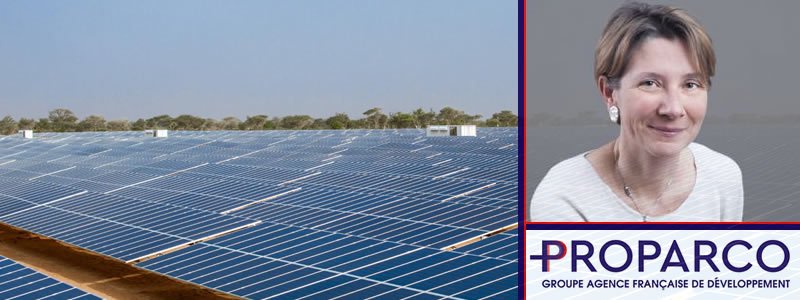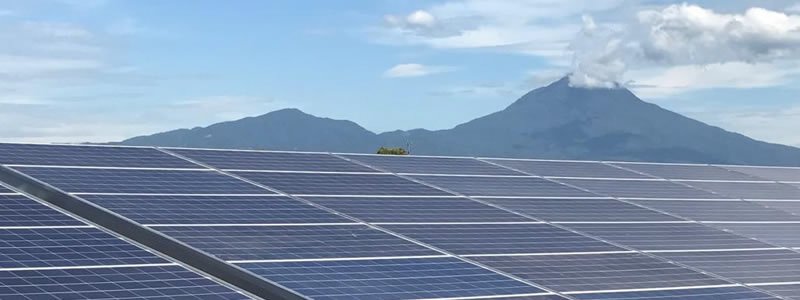
In the run-up to ‘Making Solar Bankable - Evolving Business Models in Emerging Markets’, we’re speaking to Emmanuelle Matz of Proparco (part of AFD - the French Development Agency) to speak about their solar development & financing related activities in emerging markets in Africa, Asia and Latin America.
AFD Group is today one of the most committed donors on the “climate” issue. Proparco earmarks 30% of its operations for projects that contribute to the fight against climate change – mainly via the development of renewable energies and energy efficiency. Proparco has already committed over €2 billion in 27 different countries to fighting climate change and is committed to devoting another €2 billion in new commitments between 2017 and 2020.
Key insights
-
Sustainable regulatory schemes must be coupled with strong political willingness in order to support feasible investments
-
The future of electricity will be a combination of off-grid and on-grid energy
-
Storage technology will create new opportunities and breach the limiting constraints of unreliable grids
-
Main challenge remains to create the right conditions to attract investors on a long-run basis
-
Many projects lead by the public sector; DFIs need to pick up on change and pull commercial financing along

Image: Proparco
How is Proparco currently involved in financing solar PV in emerging markets?
Proparco has been active in supporting the development of solar PV in Emerging markets since 2010, creating a portfolio amounting to 880M€ in wind and solar projects. For instance, we financed through a mezzanine facility the first PV plant built in the Latin American continent: a 25MW plant in Peru developed by Solarpack and built by T solar.
Since then, we have supported the initiatives developed by the countries that have demonstrated a strong interest in developing their local solar potential: countries such as India, where electricity produced from solar energy has become more competitive than the one issued from coal, Central American countries and Jordan, one of the most advanced countries in this field.
More recently, we have been active in Africa: Proparco arranged the financing of the first two solar plants developed by the private sector in Western Africa, in 2016, for Meridiam in Senegal.
Last year, after two years of intense discussions with the Egyptian Authorities alongside IFC and EBRD to ensure the bankability of the project documents implemented to launch the first Feed-in tariff program of the country, we financed five projects for Access Eren, EDF EN and Voltalia. These solar farms will be built on the largest solar site ever identified, which successfully attracted investors who committed to develop 1.5GW, at Benban, close to Assouan.
In which emerging markets, and which segments, does Proparco see opportunities for solar PV development to gain traction and expand?
Thanks to its competitiveness, solar PV is becoming universal. That said, a lot of countries are still initiating new programs: some large countries, such as Egypt and Argentina only started last year and still have an extensive potential to develop; others are still in the learning curve to deploy the right measures to attract investors, such as Ethiopia or Vietnam. Africa has not developed yet its full capacity and the high irradiation potential offers huge potential.
In terms of segments, we expect that the storage technology will create new opportunities, breaching the current limiting constraints of African grids for instance. In addition, to cope with those constraints, an off-grid environment is emerging. Its right economical model still needs to be defined but just as mobile phones allowed Africa to overcome development steps in technology, one could expect some similar outcome in the energy sector.

Image: Proparco
What is needed - eg. in terms of regulatory or market conditions - in order for solar PV to reach its true potential?
A lot of successful results have been achieved in different countries, demonstrating that solar PV can significantly contribute to national electricity production, thanks to its competitiveness, when large scale programs can be implemented. Take a look at the Emirates or Mexico!
That said, the answer is not unique. In Africa, the effort needs to be shared between public and private parties. Let’s revert to Senegal: why has it been successful? The Ministry of Energy, jointly with SENELEC, identified at an early stage the attractiveness of solar compared to the production cost of thermal plants. Thanks to capacity-building provided by AFD and the World Bank to support them in the monitoring of a grid that would include intermittent energy, they decided to invest in their solar potential.
Why did investors come? The regulatory scheme for IPPs has been in place for more than ten years now, giving confidence to the private sector to engage development costs and invest on a long-term basis, as well as to private lenders to support such initiatives and provide attractive financings.
Yes, a sustainable regulatory scheme is a must, but it needs to be coupled with a strong political willingness to support the feasibility of the investments.
What will be the roles for on-grid and off-grid solar PV in the electrification of emerging markets?
It is clear that in Africa, a continent where 600 million people do not have access to electricity but where local governments have to arbitrate between different priorities and budgets, much-required investments in transmission lines expansion may still be delayed. The future of electricity will thus be a combination of off-grid and on-grid energy. Whilst African cities are better and better connected, the last mile of each transmission line remains the challenge to overcome to bring electricity to small villages.
The B to B business is emerging as well: the ESCO market to Towercos, originally created in India, is expanding in some countries in Central or Western Africa. In very densified areas lacking infrastructures, such as in DRC, mini-grids initiatives are emerging.
How much is Proparco looking at innovative technologies (eg. energy storage, blockchain-applications) and business models (eg. leasing, sharing, PAYG) in emerging markets versus supporting conventional types of solar plant development?
Supporting new technologies implies affording higher risks. In the PV solar space, this rule is also valid; to support the development of the off-grid market, Proparco has selected to address the funding market by investing in private equity, in the geographical area which is historical to us: Africa.
We have invested in Energy Access Ventures (EAV), a fund dedicated to investing in off-grid actors and solutions: PAYG, mini-grids, B to B initiatives. In addition, being 7 Pillars assessed, we signed the ARESUF facility with the EU, a €12M guarantee facility to support direct investments amounting to €1 to 4 million to help off-grid players scale up their activity.

Image: Proparco
What are the key challenges Proparco faces with financing solar PV projects in emerging markets?
The challenges are related to the level of maturity of the markets: the more mature the markets, the larger the projects and the more competitive they are, requiring financing inventiveness and very high competitiveness.
In less-advanced countries, the main challenge is to create the right conditions to attract investors on a long-run basis, i.e. by implementing adequate governance rules, establishing bankable project documentation, ensuring risk-mitigation schemes to allow the lenders to afford the offtaker risk and securing capacity-building to the public partners.
The incentive of PV solar is that it can deliver electricity on the short run at a cost that is always by far more competitive than conventional options. This is why it increasingly attracts governments.
What characterizes Proparco’s approach in dealing with these challenges and overcoming the hurdles?
As a development financial institution, our role is to be complementary to the existing financing offer. As a consequence, in more developed countries, we will focus more on mezzanine financing or equity, on a portfolio approach, whilst in the majority of the countries where we are active, we will contribute to creating a bankable environment, jointly with our parent company AFD, and provide long-term debt financing.
Where does Proparco expect solar PV development to be in emerging markets by 2030 and how does it look to contribute to that vision?
I wish we could have such long term view…
We anticipate that storage could be the next revolution for the market and closely look at the evolution of the prices of the different options that are emerging, pushed by the car industry. One can anticipate that, facing such a revolution, lenders prefer to take part in it, once it has been proven! It is the role of DFIs to support this kind of changes, and to pull commercial banks along. In this field as well, we will go on playing our role.
However, the few projects we have seen as of today are rather lead by the public sector, such as this national initiative Tunisia is implementing to ensure a comprehensive development of its cities.
